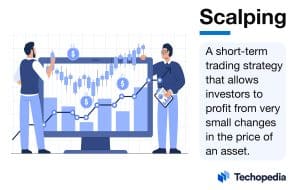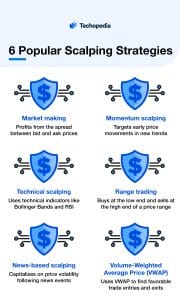What is Scalping in Trading?
Scalp trading is a short-term trading strategy that allows investors to profit from very small changes in the price of an asset.

Key Takeaways
- Scalpers can execute hundreds of trades in a single day.
- There are a variety of scalping strategies that look to take advantage of tiny changes in price.
- Short holding periods reduce the risk for scalpers.
- To be successful, scalpers need advanced trading tools and real time data.
- Scalping can be extremely stressful and time-consuming.
Who is a Scalper?
According to the scalping definition, a scalper is anyone who is utilizing a scalp trading strategy. Scalpers often use technical analysis, high-speed trading platforms, and advanced technological tools to execute their trading strategy successfully.
Scalping isn’t limited to financial professionals and can be done by anyone at any time, regardless of their trading experience.
However, scalping can be an extremely stressful financial strategy and, therefore, is usually only a good choice for investors who are prepared to closely monitor their trades and invest without making emotional decisions.
How Scalping Works
Scalpers take advantage of very small price movements to “scalp” small gains from numerous trades in a single day. A scalper might only hold a position for a matter of seconds or minutes before selling it to lock in a profit.
Scalpers usually select highly liquid assets, like forex pairs or high-volume stocks, that can be quickly bought and sold. This way, the scalper isn’t left holding an asset for longer than they wan, and they can exit their trade at any time, whether for a profit or loss.
While historically brokers charged trading fees, today, there are plenty of online zero-fee brokers where scalp traders can execute trades without paying a commission. This is very important as it helps scalpers, who can place hundreds of trades each day, keep their profits.
Day Trading vs. Scalp Trading
Time Frame: Minutes to hours
Number of Daily Trades: 1-10
Expected Outcomes: Larger profit targets with significant price movements
Skills Required: Knowledge of technical analysis, trading strategies, and market trends
Tools: Technical analysis software, trading platforms
Stress: Moderate to high
Time Frame: Seconds to minutes
Number of Daily Trades: 10-100+
Expected Outcomes: Small margins per trade with minuscule price movements
Skills Required: Understanding of market structures, speed, and discipline
Tools: Advanced trading platforms, real time data, Level II quotes
Stress: Very high
6 Popular Scalping Strategies
Scalping in Financial Markets
Financial markets provide scalpers with the perfect environment to execute a profitable trading strategy. For many financial assets, there are regular price movements and swings that can be exploited to scalpers benefit.
Additionally, by utilizing time-tested technical indicators, scalpers can get a sense of the short-term direction of an asset. Historically, the forex market has been a great place for scalp traders along with high-volume stocks.
However, in recent years, scalpers have entered into the cryptocurrency market where trading volumes have steadily increased and the opportunity for scalping has grown.
How to Scalp Trade
- Select a liquid asset.
- Use technical analysis to identify a potential short-term price movement.
- Execute trades with high-speed Internet and advanced trading platforms.
- Manage risk by using stop-loss orders and small position sizes.
- Stick to your trading plan and avoid making emotional investment decisions.
Scalping Pros and Cons
Pros
- There may be numerous scalping opportunities on any given day
- Can make quick profits in a matter of seconds or minutes
- Short holding periods reduce market exposure
- Can yield steady profits if executed correctly
Cons
- Need to constantly monitor prices and markets
- Can be a very stressful strategy to implement
- May need specialized trading tools to be successful
- Short-term capital gains taxes can eat away at profits
The Bottom Line
Scalp trading is a very fast-paced strategy that allows traders to exploit small price movements for a profit. To trade successfully, scalpers must have a firm knowledge of technical analysis, the ability to make quick decisions, and manage risk. The scalping meaning revolves around the ability to take advantage of minor market fluctuations to achieve cumulative gains.
Scalping does have the potential for fast profits and limited market exposure, but it’s also extremely demanding, time-consuming, and stressful and is usually best left to advanced traders.







